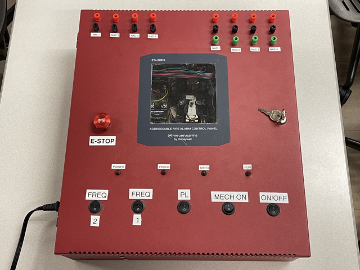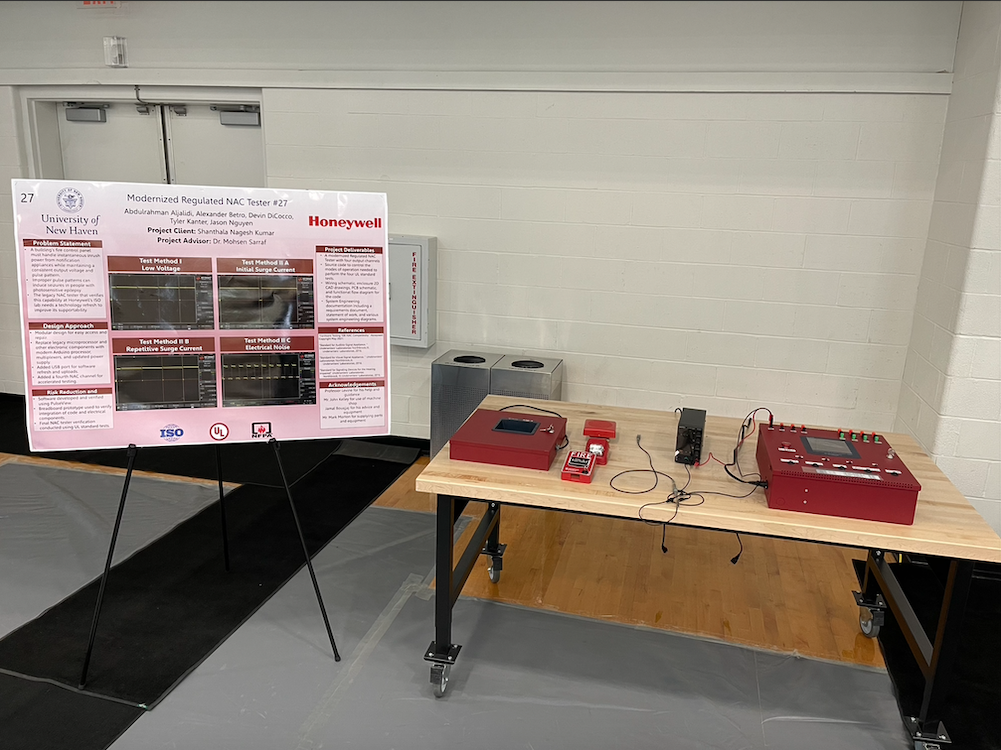August 2022 – May 2023
For my senior capstone design project, my team and I were sponsored by Honeywell Fire-Lite to re-engineer and re-design a Regulated Notification Appliance Circuit (NAC) Tester box. This tester box would be used and replicated throughout the entire Fire-Lite facility in Northford, CT. Please note that due to a non-disclosure agreement, some details or features were not discussed here.
A Notification Appliance Circuit, or NAC, tester box tests the entire spectrum of fire notification devices. This includes flashers, speakers, and the fire panels themselves. In the event of unexpected disturbances, a notification circuit must continue to operate as intended. If the circuit is inoperable or malfunctions at any point, the entire circuit could fail in protecting those in life-or-death scenarios.
Currently, the engineers at the Fire-Lite facility are using an outdated and unsupported tester box to test their appliances. The box can only test one fire panel at a time, and the facility has no documentation in regards to the box. The original box used a proprietary Allen-Bradley PLC, custom coded by an employee that is no longer with the company. This means any upgrades, like those to increase the amount of panels it can test at once, could not be done. What my team and I strove to accomplish was a newly updated tester box capable of testing two fire panels at once with components that are easy to upgrade and supporting documentation, all in a modular enclosure. Not only would this facilitate future upgrades and reproduction, the box itself increases productivity by 100%, and provides a safer and risk-free environment for the tester(s) themselves.
Initial Prototypes

My team and I created an initial prototype using an Arduino Uno, a breadboard, a single solid-state relay, a sheet of plywood, cardboard, and various wires. This prototype was created to:
- verify code functionality
- verify component functionality
- verify the accuracy of relay timing and test functions
To verify the test conditions, a Saleae-based USB logic analyzer was used. The logic analyzer allowed us to verify that the lengths of each test condition met or exceeded the requirements put forward by UL standards.

Test Conditions
The tester box required four different test cases to replicate four different potential disturbance scenarios.
Test Method I
Test Method I simulates a low voltage. This test ensures that the test panel can continue to output within the voltage range in the case of a drop in voltage, such as during a brownout.
Test Method II-A
Test Method II-A simulates an initial surge current. This test ensures that the test panel does not misfire, reset, or fail in the case of initial inrush current, such as when the alarm is first activated.
Test Method II-B
Test Method II-B simulates a repetitive surge current. This test ensures that the test panel can handle the repetitive surges of current while an alarm is active.
Test Method II-C
Test Method II-C simulates electrical noise. This test ensures that the test panel is not affected by the electrical noise of mechanical components, such as the chatter of a school bell. This test uses mechanical relays in place of the solid-state relays used in the other three test methods.
Final Design
Our final design featured four solid-state relays, four mechanical relays, a custom-designed PCB, five rocker switches, four status LEDs, an emergency stop button, and a 12V power supply. The final cost of the entire box was calculated to be $1,100, less than half of their planned budget of $3,000.
Compared to their old design, the new tester box features:
- an extra set of banana jacks on the front panel to increase testing capability to two simultaneously
- an Arduino microcontroller on the PCB for quick code uploads and future updates
- removable mounting plates and wires for a more modular design
- new rocker switches for a more ergonomic design
- an emergency stop button to cut off 120V power to the box
- fuses for internal circuit protection
Final Results


The team and I presented and demonstrated our project to the Honeywell Fire-Lite team on April 27, 2023.


The team and I presented and demonstrated our project at the University of New Haven Capstone Expo on May 2, 2023.




Special thanks to Dr. Mohsen Sarraf and Professor Laurence Levine from the University of New Haven, as well as Michael Yanofsky and Shanthala Nagesh Kumar from Honeywell Fire-Lite for their dedication and guidance throughout the entire year.
View our project presentation here.